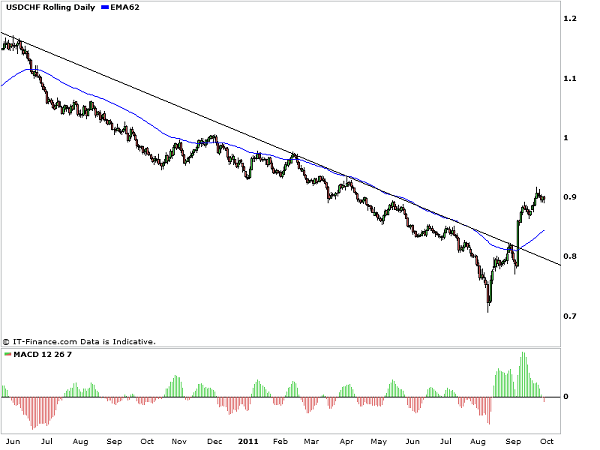The rumour-mill was going into overdrive before the key German vote on expanding the European Financial Stability Fund, suggesting that it would only just scrape through parliament if at all. This remote but entirely plausible possibility was the reason for a widespread sell-off during the US trading session late on Wednesday. Nobody fancied being long the Euro when news came that Angela Merkel had lost what had become more of a national referendum on here leadership than purely an economic decision. Of course, the vote was passed by an overwhelming majority of 533 to 85 and this reflected a major boost and vote of confidence not only for Merkel but also in the Eurozones ability to overcome the problems of being able to provide financial assistance to its blighted members.

USD/CHF Breakout Formation
The strange trading phenomenon of positive news creating a negative reaction occurred almost immediately after its release. This could have been the fact that many traders were already looking beyond the backing of Merkel and towards the troupe of European auditors currently assessing Greek progress. Demonstrations were widely reported across European capitals as the IMF and European Commission were expected to turn the austerity screw even further on a country already painfully close to the edge. The Euro regained some of its initial losses as conversations turned more positive and the belief that Germany would be able to persuade other members to ring fence a financial package for Greece and she would be able to be coaxed back from the edge of the cliff.
EUR/USD Daily Chart
For the forex markets there is a lot of reading between the lines to be done. Even when news as black and white as parliamentary votes occurs the situation is rarely as straightforward and fundamentals very often conflict. We are at the end of the month and also at the end of the third quarter so markets perhaps are not reacting as they may do otherwise. Currencies also often hit their extreme highs and lows at the beginning and end of the month. The USD is quite possibly an example of this. Technically, on the higher timeframes, it looks as though it may still have more upside potential, contradicting the view that risk appetite has returned if only for a short period. The EUR/USD on the other hand appears also to have broken out of its eighteen-month trend, cascading downwards with Europe’s financial woes. Despite this, and considering the speed of the rise and fall of these two major currencies and the ease at which they have broken out of their respective trends, it would not be impossible to think that they could be due a significant correction back to these areas . If technical analysis existed in a bubble then this would be almost a logical certainly, but with fundamentals running the show it becomes far more emotive than analytical.
Comments (No)